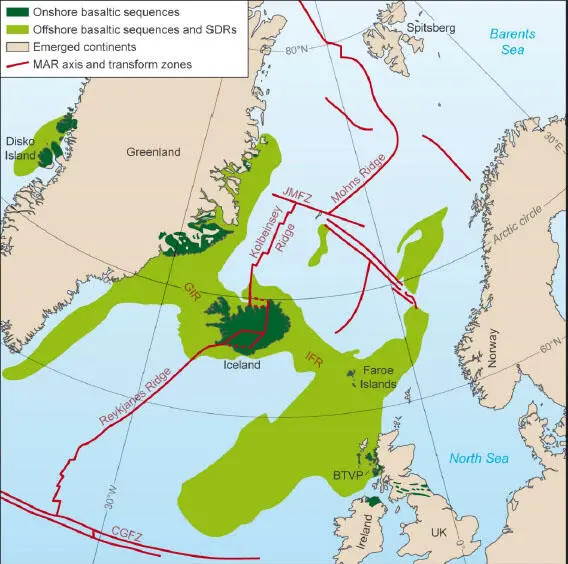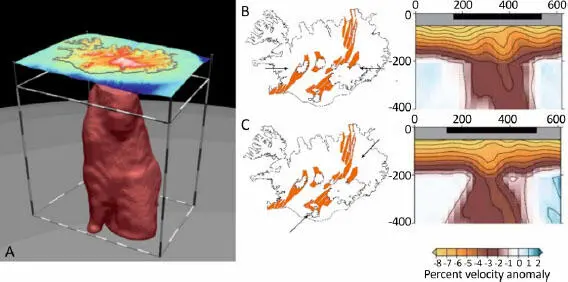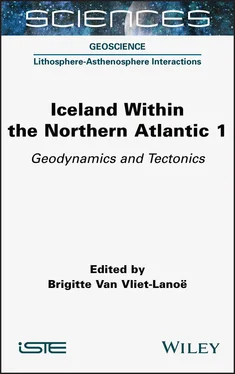The North-MAR is a slow to ultra-slow ridge whose rate of expansion decreases toward the north (Le Breton et al. 2012). This rate varies from about 21 mm/year at the axis of the Reykjanes Ridge (slow ridge southwest of Iceland) to 16 mm/year at the Mohns Ridge (north of Jan Mayen). It becomes close to only 6 mm/year in the cold Arctic Ocean at the end of the ultra-slow Gakkel Ridge (Jokat et al. 2003), near the pole of rotation between the Eurasian and North American plates, located in the extreme East of Siberia. In Iceland, the rate of expansion at the axis of the ridge is of the order of 20 mm/year. The complex genesis of the North-MAR and its evolution during the Cenozoic are presented in Chapter 3( section 3.2).
1.2.2. The North Atlantic Igneous Province
The North Atlantic Igneous Province (NAIP) is a basaltic province of the North Atlantic formed during the Paleogene. Before the opening of the North Atlantic, it extended over a large area (Saunders et al. 1997). Significant remnants of it exist mainly in Northern Ireland, Scotland, the Faroe Islands, and western Greenland ( Figure 1.5and Chapter 3).
At the end of the Cretaceous, the North America–Greenland–Europe region had no significant volcanic activity. Oceanic expansion was taking place between Canada and the southern Labrador Sea. Around 62 My, volcanic eruptions began in a vast region with extensive magma activity (intrusive and extrusive), notably in western Greenland (Chauvet et al. 2019) and in the sector of the Hebrides Islands (Wilkinson et al. 2016) and continued until 56 My.
1.2.3. The Icelandic hot spot
The concepts of hot spot and mantle plume, born at the same time as plate tectonics, are due to John Tuzo Wilson (1963) and Jason Morgan (1971). The first suggested, based on the case of Hawaiian volcanoes, that oceanic volcanic chains could constitute the trace left on a moving lithospheric plate of a fixed magma source located beneath this plate; the second proposed that the feeding of this fixed source was an abnormally hot plume rising from the base of the mantle (layer D’’). Over the next half-century, geophysical and geochemical measurements, numerical modeling and laboratory experiments have refined and consolidated Wilson–Morgan’s theory.
The link between plumes and the vast lava flows that constitute the large igneous provinces (traps and oceanic plateaus) was proposed in the 1980s (Courtillot et al. 1989), the idea being that, when the plumes come close to the surface, they thermally thin the lithosphere and generate very large magmatism. The volumes and rates of magmatic production are of the same order of magnitude as those of the ridges or arcs of the subduction zones. The NAIP would thus have been classically fed by a plume precursor to the one underlying the Icelandic hot spot.
Fluid mechanics have developed a “standard model” of a mantle plume, in which the plume is in the form of a long, narrow conduit – the tail of the plume – topped by a mushroom-shaped head below the lithosphere. Nevertheless, there are several variants of this model, some suggesting that the plumes flow toward and along the ridges through pipe-like channels, others through pancake-like gravity currents (see references to these works in Ito et al. 2003). The thickness of the oceanic crust in the Northeast Atlantic is abnormally high, as is the thickness of the mafic crust located between Greenland and the Faroe Islands. This is classically interpreted as a demonstration of abnormally high mantle melting rate, associated with a warmer than “normal” asthenospheric mantle (White and McKenzie 1989).

Figure 1.5. The North Atlantic Igneous Province (from Storey et al. 2007; Thodarson and Larsen 2007; Chauvet et al. 2019)
COMMENT ON FIGURE 1.5.– GIR: Greenland–Iceland Ridge; IFR: Iceland–Faroe Islands Ridge, connecting the Icelandic hot spot with volcanic accumulations in the British Tertiary Volcanic Province (BTVP) south of the Faroe Islands; CGFZ: Charlie–Gibbs Fracture Zone; JMFZ: Jan Mayen Fracture Zone .
Icelandic magmatism is commonly genetically related to the Paleogene magmatism of NAIP. It seems therefore related to a unique mantle plume that has existed for more than 60 My ( Figure 1.6). Iceland could thus be interpreted as a residual plume axis (tail) whose “cap” is cooled.

Figure 1.6. Seismic imaging of the upper mantle at the Icelandic hot spot
COMMENT ON FIGURE 1.6.– Imagery illustrating the narrow cylindrical shape of the mantle plume (A), with a radius of about 150 km (low velocity anomaly to a depth of at least 400 km) (from Wolfe et al. 1997). Vertical sections in the ICEMAN model by Allen et al. (2002) perpendicular (B) and parallel (C) to the rift. These sections illustrate the vertical conduit between 400 and 200 km deep and the horizontal plume above .
However, in spite of the numerous studies carried out over a period of 50 years, knowledge about hot spots and the internal phenomena that cause them is still very incomplete. Numerous controversies remain (Courtillot et al. 2003; Campbell 2007). The spatial stability of hot spots is also questioned (Tarduno 2010) and the very reality of deep plumes is still debated (Anderson 2001; Montagner 2010).
As regards the Icelandic hot spot, no satisfactory model is currently available to account for all the very large amount of structural, tectonic, geochronological and petro-geochemical data available. The basic problem concerns the relationships between (i) a geochemical signature, suggesting an origin from the underlying deep mantle, (ii) the extensive deformation related to the ridges adjacent to and across the island, inducing adiabatic fusion at greater or lesser depths in the mantle, and finally (iii) the inheritance and recycling of ancient geological structures affecting the crust, such as the ancient oceanic suture and mantle in this particular area of the Atlantic, which may pollute the observed geochemical signatures.
The first oppositions to the deep plume model appeared in the early 2000s with the work of Foulger and her collaborators (Foulger et al. 2001, 2005; Foulger and Anderson 2005). For these authors, the large amount of magma produced in Iceland is thought to originate from the reworking of the subducted and eclogitized oceanic crust of the ancient Iapetus Ocean.
Several conferences, organized by pro- and/or anti-plume groups, were devoted to these issues during the first decade of the 21st century (in particular, a Penrose Conference held in Iceland in 2003, and the Great Plume Debate in Scotland in 2005), but the debate is far from over (Campbell and Kerr 2007; Meyer et al. 2007; Foulger 2012). Recent studies are still rehashing cards and, even among “pro-plume” authors, the spatial and temporal evolution of the latter is still the subject of work (Barnett-Moore et al. 2017; Martos et al. 2018). We will review the latest developments concerning the Icelandic hot spot in Chapter 3and Chapter 1of Volume 2.
1.2.4. The Greenland–Iceland–Faroe Ridge
The Greenland–Iceland–Faroe Ridge (GIFR) consists of a shoal interspersed with three fairly deep channels (about 2,000 m), which steers the North Atlantic from Greenland to the Faroe Islands, leaning against Iceland. It forms a relief of crucial importance not only as a recording of the last phases of the opening of the North Atlantic, but also for understanding the formation of the current thermohaline circulation, one of the major drivers of the evolution of our climate.
Читать дальше














